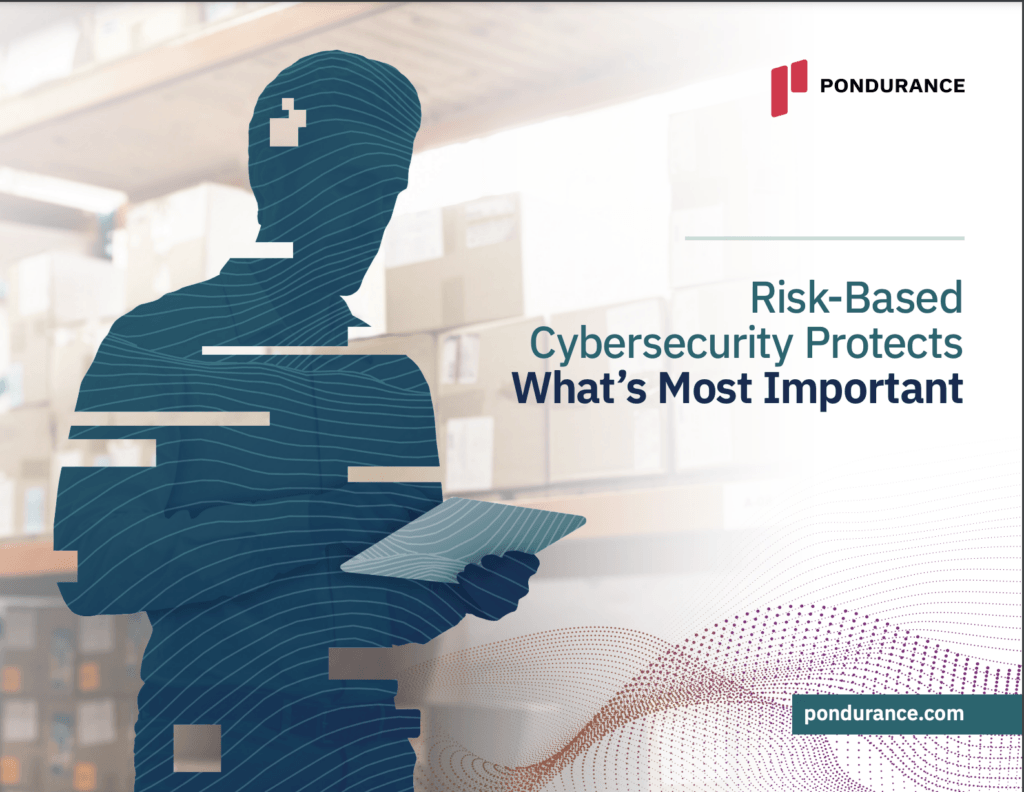Our privacy policy is located here.
Risk-Based Cybersecurity
Your cybersecurity approach should align with your company’s objectives, outcomes, and risks — making a risk-based approach to cybersecurity the best strategy for your business.
Risk in Cybersecurity Comes in Many Forms
But Pondurance's Risk-Based Approach Helps You Protect what matters most
Defend What's Most Important
With a Risk-Based Cybersecurity Approach

Learn more about our risk-based approach, and dynamic defense methodology
Dustin Hutchison, Ph.D.
Protect What Matters Most with Risk-Based Cybersecurity
Pondurance — the first and only MDR provider to be built around a risk-based approach — believes a risk-based approach is the best way to protect clients from threats and reduce their exposure to attacks.

Learn more about a risk-based MDR approach
an Interview with ISMG and Doug Howard



Risk in Cybersecurity
Risk in cybersecurity is a pervasive concern that encompasses a broad spectrum of malevolent activities perpetrated by various actors with malicious intent. These actors leverage technologically-advanced assets to exploit vulnerabilities in digital infrastructure, software, and data systems, leading to incidents such as data breaches, financial scams, cyber espionage, phishing attacks, malware infections, and even cyber warfare.
Understanding the implications of cyber risk management is crucial, as it can profoundly impact both businesses and individuals. Consequences may include the compromise of sensitive data, substantial financial losses, reputational damage, identity theft, and even the destabilization of a nation’s socio-economic infrastructure. The interconnected nature of the internet and digital technologies exacerbates these risks, making cybersecurity a global concern with relentless threat actors.
Examples of significant cyber risk incidents abound, each presenting unique challenges. The SolarWinds hack demonstrated how cyber-espionage can infiltrate even the most secure government systems. Similarly, the WannaCry ransomware attack paralyzed thousands of computers globally, affecting businesses, hospitals, and government agencies. The Equifax breach exposed vulnerabilities in digital data storage systems, compromising the personal details of millions of customers.
Addressing these challenges requires a robust, strategic approach to risk management in cybersecurity. This involves analyzing, assessing, and prioritizing threats while implementing robust security measures. Strategies may include monitoring network activity, employing strong encryption, maintaining updated software, conducting regular security audits, and educating staff on safe practices.
Technological advancements have led to the emergence of risk-based cybersecurity, which emphasizes quantifying risks and prioritizing resources to mitigate the most significant threats. This approach enables organizations to optimize their defense strategies and align cybersecurity efforts with organizational goals, ensuring business continuity and resilience.
Pondurance, a prominent cybersecurity company, exemplifies the effectiveness of a risk-based approach in fortifying against cyber threats. By analyzing an organization’s risk profile, detecting anomalies, and implementing countermeasures, Pondurance helps mitigate potential threats using threat intelligence, technology, and human analysis, fostering a secure digital environment.
In conclusion, addressing risk in cybersecurity is essential in today’s interconnected world. It requires comprehensive risk management strategies, progressive approaches, and collaboration with industry leaders like Pondurance to effectively identify, manage, and reduce cybersecurity risks, ultimately fostering a resilient and secure digital landscape.
Classifying Risks in Cybersecurity
Classifying risks in cybersecurity is an essential undertaking for any astute business. This classification furnishes informed strategies to mitigate inherent risks intrinsically entwined with the rapidly evolving technology landscape. A comprehensive approach to this topic necessitates an exploration of the varied types of risk in cybersecurity that all businesses must contend with.
Typical types of risk in cybersecurity include operational, reputational, legal and compliance risks. Operational risk refers to disruptions in system operations due to a cyber attack, which can lead to productivity loss and financial repercussions. Reputational risk emanates from the potential damage to a business’s credibility following a cybersecurity failure, leading to reduced customer trust and business opportunities. Legal risks are associated with potential lawsuits following a data breach, while compliance risks involve penalties for violating industry-specific cybersecurity regulations.
Several robust measures to combat these risks are available in the market. Among them, continuous monitoring, regular system updates, training personnel to identify threats, and adopting stringent cybersecurity protocols can significantly reduce risk exposure.
Pondurance, a leading risk-based cybersecurity firm, offers tailored solutions to mitigate these risks. With its specialized services, Pondurance brings robust cybersecurity frameworks, advanced threat hunting techniques, and comprehensive security programs to the table, all specifically geared to address different types of risk in cybersecurity.
An effective cybersecurity strategy is no longer a luxury – it’s a necessity. It’s a strategic imperative that aims to protect an organization’s valuable assets and maintain customer trust. Through detailed classifications and understanding of cybersecurity risks and having the right partner like Pondurance, businesses can better prepare, respond, recover, and thrive in today’s digitally interwoven world.
Measuring Risk in Cybersecurity
The landscape of global cyber infrastructure is a constantly evolving arena with emerging security threats and vulnerabilities. Measuring risk in cybersecurity has become crucial for businesses of all sizes as part of their strategic objectives. This process involves assessing the vulnerability of digital systems, including information systems dealing with sensitive information or financial transactions, to potential cyber threats.
Risk assessments in cybersecurity involve the systematic identification and evaluation of potential threats to an organization’s digital properties and resources. Cyber risk assessment can consist of a plethora of techniques and methodologies to measure these threats and distinguish overall risk. One primary tactic is a vulnerability scan, a technical assessment aimed at identifying system weaknesses. This process ranges from automated systems scanning for known vulnerabilities to manual testing by cybersecurity professionals to detect subtle or novel risks.
Effective cybersecurity risk measurement and management require a proactive and knowledgeable approach. This is where Pondurance, a leading risk-based cybersecurity firm, steps in with a comprehensive suite of cybersecurity services. Pondurance assists organizations in identifying, assessing, and mitigating cybersecurity risks.
Pondurance’s risk management strategies focus on proactiveness and capability restoration instead of solely offering barriers against potential attacks. This methodology positions Pondurance at the forefront, delivering tangible, measurable results in cybersecurity risk reduction to help businesses navigate the digital world safely.
Role of Risk Management in Cybersecurity
Risk management plays an indispensable role in today’s cybersecurity landscape. The digital age has presented us with an array of innovative technologies, but with these technological advancements come substantial risks. These risks are mired in the complex intricacies of data privacy and security, thus making risk management in cybersecurity a crucial aspect for organizations.
With the ever-growing predominance of cyber threats, companies must navigate cybersecurity managing risk in the information age. A robust cybersecurity risk management strategy requires a deep understanding of the potential risks and effective measures to combat those threats. Typically, this strategy encompasses several steps including risk identification, subsequent analysis, thorough evaluation, and treatment.
Risk identification involves pinpointing the areas with potential vulnerabilities. As part of the risk analysis phase, these discovered vulnerabilities are scrutinized to comprehend the nature and level of threat they pose. This understanding is vital in evaluating the risk, following which, the most suitable treatment options are decided upon to address the identified risk.
Pondurance, as a leading risk-based cybersecurity firm, stands potent in assisting businesses to manage their cyber-related risks effectively. Their holistic approach ensures that every facet of cybersecurity risk management is addressed, providing a robust shield to their clients’ confidential information.
The significance of risk management in cybersecurity cannot be overstressed. It arms organizations with the much-needed armor to protect themselves against varied cyber threats. Effective risk management not only helps in identifying and assessing the risk but also aids in better decision making suited to their individual needs.
In conclusion, stringent cybersecurity risk management practices coupled with strategic engagements with industry leaders like Pondurance ensures that organizations continue to flourish in this information age, amidst a maze of potential cyber threats. For all its complexities, risk management truly lies at the heart of cybersecurity.
In today’s rapidly evolving digital landscape, a risk-based approach to cybersecurity is paramount for organizations to thrive amidst potential cyber threats. Pondurance, a leader in the industry, leverages this approach to provide tailored defense against advancing cyber risks. By prioritizing critical assets and vulnerabilities, Pondurance fortifies clients against the dynamic cybersecurity landscape. Emphasizing the integration of risk assessment into cybersecurity practices, Pondurance champions a secure digital future. Through strategic partnerships with industry experts like Pondurance, organizations navigate the complex cybersecurity terrain with resilience and success. It is evident that robust risk management practices underpin the very essence of cybersecurity, ensuring organizations effectively combat modern cyber threats and safeguard their operations in the information age.
